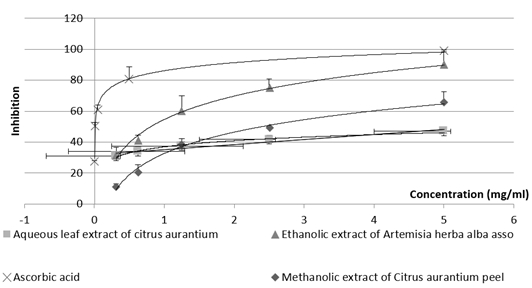Antioxidant activity of extracts formulated from Citrus aurantium and Artemisia herba alba
Abstract
Plants still present a large source of novel active biological compounds with different activities. The antioxidant activity of three extracts was evaluated by DPPH and ferric reducing antioxidant power methods. The formulated extracts were analyzed by thin layer chromatography (TLC) and then confirmed by High performance liquid chromatography coupled with DAD detector (HPLC-DAD). The results showed the richness of these extracts in phenolic compounds. Three major compounds, resveratrol (17.98%), kaempferol-glucoside (7.23%) and vanillic acid (10.64%) were detected in methanolic extract of Citrus aurantium peel, aqueous extract of Citrus aurantium L. leaves and ethanolic extract of Artemisia herba alba Asso respectively by HPLC-DAD. However, the ethanolic extract of A. herba alba achieved 50% of the anti-radical activity at a concentration equal to 0.8 mg/ml. A higher antioxidant activity measured by ferric reducing antioxidant power was marked in the same extract with an absorbance equal to 0.824. The ethanolic extract of the aerial part of A. herba alba, the methanolic extract of C. aurantium peel and the aqueous extract of C. aurantium leaves were considered as powerful scavengers of free radicals and can be incorporated into the pharmaceuticals preparations to treat many diseases.
Downloads
References
2. IUCN, eds. A guide to medicinal plants in North Africa. France, Amazon, 2005.
3. Wright CW, ed. Artemisia. United Kingdom, CRC Press, 2003.
4. Manthey JA, Guthrie N, Grohmann K. Biological properties of citrus flavonoids pertaining to cancer and inflammation. Curr Med Chem. 2001; 8: 135-153.
5. Boussaada O and Chemli R. Chemical composition of essential oils from flowers, leaves and peel of Citrus aurantium L. var. amara from Tunisia. J Essent Oil-Bear Plants. 2006; 9(2): 133-139.
6. Santhosh NA, PV A, Baby NN. Evaluation on antimicrobial activity of fruit peels of selected citrus species against human pathogenic microorganisms. J Pharmacogn Phytochem. 2015; 4(3): 278-281.
7. Céspedes CL, Sampietro DA, Seigler DS, Rai M, eds. Natural antioxidants and biocides from wild medicinal plants. UK, CABI, Oxfordshire, 2013.
8. Perva-Uzunalic A, Skerget M, Knez Z, Weinreich B, Otto F, Grucher S. Extraction of active ingredients from green tea (Camellia sinensis). Extraction efficiency of major catechins and caffeine. Food Chem. 2006; 96(4): 597-605.
9. Lairini S, Bouslamti R, Zerrouq F, Farah A. Valorisation de l'extrait aqueux de l'écorce de fruit de Punica granatum par l'étude de ses activités antimicrobienne et antioxydante (Enhancement of the aqueous extract of the bark of Punica granatum fruit through the study of its antimicrobial and antioxidant activities). J Mater Environ Sci. 2014; 5(S1): 2314-2318.
10. McCollom MM, Villinski JR, McPhail KL, Craker LE, Gafner S. Analysis of macamides in samples of Maca (Lepidium meyenii) by HPLC-UV-MS/MS. Phytochem Anal. 2005; 16: 463-469.
11. Sanchez-Moreno C, Larrauri JA, Saura-calixto FA. Procedure to measure the antiradical efficiency of polyphenols. J Sci Food Agric. 1998; 76(2): 270-276.
12. Bougandoura N and Bendimerad N. Evaluation of the antioxidant activity of aqueous and methanolic extracts of Satureja calamintha ssp. Nepeta (L.) Briq In french]. Nature Technol. 2013; 9: 14-19.
13. Yildirim A, Mavi A, Kara AA. Determination of antioxidant and antimicrobial activities of Rumex crispus L. extracts. J Agric Food Chem. 2001; 49: 411-420.
14. Ghedadba N, Hambaba L, Ayachi A, Aberkane MC, Bousselsela H, Oueld Mokhtar SM. Polyphénols totaux, activités antioxydante et antimicrobienne des extraits des feuilles de Marrubium deserti de Noé. Phytothérapie. 2015; 13: 118-129.
15. Ribéreau-Gayon P, eds. Les composés phénoliques des végétaux. Paris, Dunod, 1968.
16. Markham KR, eds. Techniques of flavonoid identification. London, Academic Press, 1982.
17. Vigor C, Vercauteren J, Montels J, eds. Travaux pratiques de pharmacognosie 1 ère partie: Les substances naturelles de la chaine du médicament 3 éme année. Montpellier, Université de Montpellier, 2010.
18. Bandyukova VA, Shinkareako AL. The thin layer chromatography of flavonoids. Chem Nat Comp. 1973; 9(1): 17-21.
19. Karimi E. Phenolic compounds characterization and biological activities of Citrus aurantium Bloom. Molecules. 2012; 17: 1203-1218.
20. He X. High-performance liquid chromatography-electrospray mass spectrometry in phytochemical analysis of sour orange (Citrus aurantium L.) Citrus aurantium HPLC. J Chromatogr A. 2007; 791: 127-134.
21. Saleh NAM, El-Negoumy SI, Abou-Zaid MM. Flavonoids of Artemisia judaica, A. monosperma and A. herba-alba; Phytochemestry. 1987; 26(11): 3059-3064.
22. Lagha-Benamrouche S, Madani K. Phenolic contents and antioxidant activity of orange varieties (Citrus sinensis L. and Citrus aurantium L.) cultivated in Algeria: peels and leaves. Ind Crops Prod. 2013; 50: 723-730.
23. Khlifi D, Sghaier R, Amour S, Laouini D, Hamdi M, Bouajila J. Composition and anti-oxidant, anti-cancer and anti-inflammatory activities of Artemisia herba-alba, Ruta chalpensis L. and Peganum harmala L. Food Chem Toxicol. 2013; 55: 202-208.
24. Ghasemi K. Antioxidant activity, phenol and flavonoid contents of 13 Citrus species peels and tissues. Pak J Pharm Sci. 2009; 22(3): 277-281.
25. Orhan IE, Belhattab R, Senol FS, Gülpinar AR, Hosbas S, Kartal M. Profiling of cholinesterase inhibitory and antioxidant activities of Artemisia absinthium, A. herba-alba, A. fragrans, Marrubium vulgare, M. astranicum, Origanum vulgare subsp. glandulossum and essential oil analysis of two Artemisia species. Ind Crops Prod. 2010; 32: 566-571.


This work is licensed under a Creative Commons Attribution 4.0 International License.




